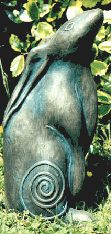 Welcome to the first in a series of four posts comprised of excerpts from Susan Bordo’s insightful book, The Male Body: A New Look at Men in Public and in Private.
Welcome to the first in a series of four posts comprised of excerpts from Susan Bordo’s insightful book, The Male Body: A New Look at Men in Public and in Private._______________________________
Studying the ancient Greeks reveals a different set of attitudes toward beauty and the body than our contemporary ideals, both homosexual and heterosexual. As is well known by now (although undiscussed when I studied philosophy as an undergraduate), Plato was not above appreciating a beautiful young body. In Symposium, he describes the beauty of the body as evidence of the presence of the divine on earth, and the original spur to all “higher” human endeavors (as well as earthly, sexual love). We see someone dazzling, and he or she awakens the soul to its natural hunger to be lifted above the mundane, transitory, mortal world. Some people seek that transcendence through ordinary human intercourse, and achieve the only immortality they will know through the begetting of human offspring and the continuation of the human race. For others, the beautiful body of another becomes the inspiration for a lifelong search for beauty in all its forms, the creation of beautiful art, beautiful words, beautiful ideals, beautiful cities. They will achieve their immortality through communion with something beyond the body – the idea of Beauty itself.So human beauty is a pretty far-ranging and powerful thing for Plato, capable of evoking worlds beyond itself, even recalling a previous life when we dealt among timeless, perfect forms. But human beauty, significantly (in fact, all earthly beauty), can only offer a glimpse of heavenly perfection. It’s our nature to be imperfect, after all, and anyone who tries to overcome that limitation on earth is guilty of hubris – according to the Greeks.Our own culture, in contrast, is one without “limits” (a frequent theme of advertisements and commercials) and seemingly without fear of hubris. Not only do we expect perfection in the bodies of others (just take a ganger at some personal ads), we are constantly encouraged to achieve it ourselves, with the help of science and technology and the products and services they make available to us.For Plato (unlike Descartes) there are no “mere” physical bodies; bodies are lit with meaning, with memory. Our culture is more Cartesian; we like to think of our bodies as so much stuff, which can be tinkered with without any consequences for our soul. We bob our “family noses,” lift our aging faces, suction extra fat, remove minor “flaws” with seemingly little concern for any “deep” meaning that our bodies might have, as repositories of our histories, our ethnic and racial and family lineage, our personalities. . . .The fact is that we’re not only Cartesian but Puritan in our attitudes toward the body. The Greeks went for muscles, sure, but they would have regarded our exercise compulsions as evidence of a system out of control. They thought it unseemly – and a failure of will – to get too self-obsessed with anything. . . .For all its idealization of the beauty of the body, Greek culture also understood that beauty could be “inner.” In the Symposium, a group of elite Greeks discourse on the nature of love. Everyone except for Socrates and Aristophanes is in love with someone else at the party, and they’re madly flirting, advancing their own romantic agendas through their speeches. Among the participants are the most beautiful young men of their crowd. Socrates himself is over fifty at the time, and not a pretty man to look at (to put it generously). Yet as we’re told at the beginning (and this seems to have been historically true), nearly everyone has at one time or another been “obsessed” with him, “transported, completely possessed – by his cleverness, his irony, his ability to weave a spell with words and ideas. Even the most dazzling Athenian of them all – soldier superhero Alcibiades, generally regarded as one of the sexiest, handsomest men in town, who joins the party late (and drunk) with a beautiful wreath of violets and ivy and ribbons in his hair – is totally, madly smitten with Socrates.Alcibiades’ love for Socrates is not “Platonic” in the sense in which we have come to understand that term. In fact, Alcibiades is insulted because Socrates has refused to have sex with him. “The moment he starts to speak,” he tells the crowd of his feelings for Socrates, “I am beside myself: my heart starts leaping in my chest, the tears come streaming down my face.” This is not the way it usually goes. In the more normal Greek scheme of things, it’s the beautiful young man – like Alcibiades – who is supposed to start the heart of the older man thumping, and who flirtatiously withholds his favors while the older lover does his best to win him. Alcibiades is in a state about his role reversal, but he understands why it has happened.He compares Socrates to a popular kind of satyr statue, which (like the little lacquered Russian dolls we’re familiar with) could be opened to reveal another figure within. Socrates may be ugly as a satyr on the outside, but “once I had a glimpse of the figures within – they were so godlike, so bright and beautiful, so utterly amazing, that I no longer had a choice – I just had to do whatever he told me.”Excerpted from The Male Body: A New Look at Men in Public and in Private by Susan Bordo.

































